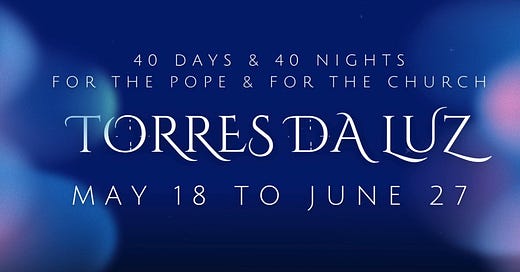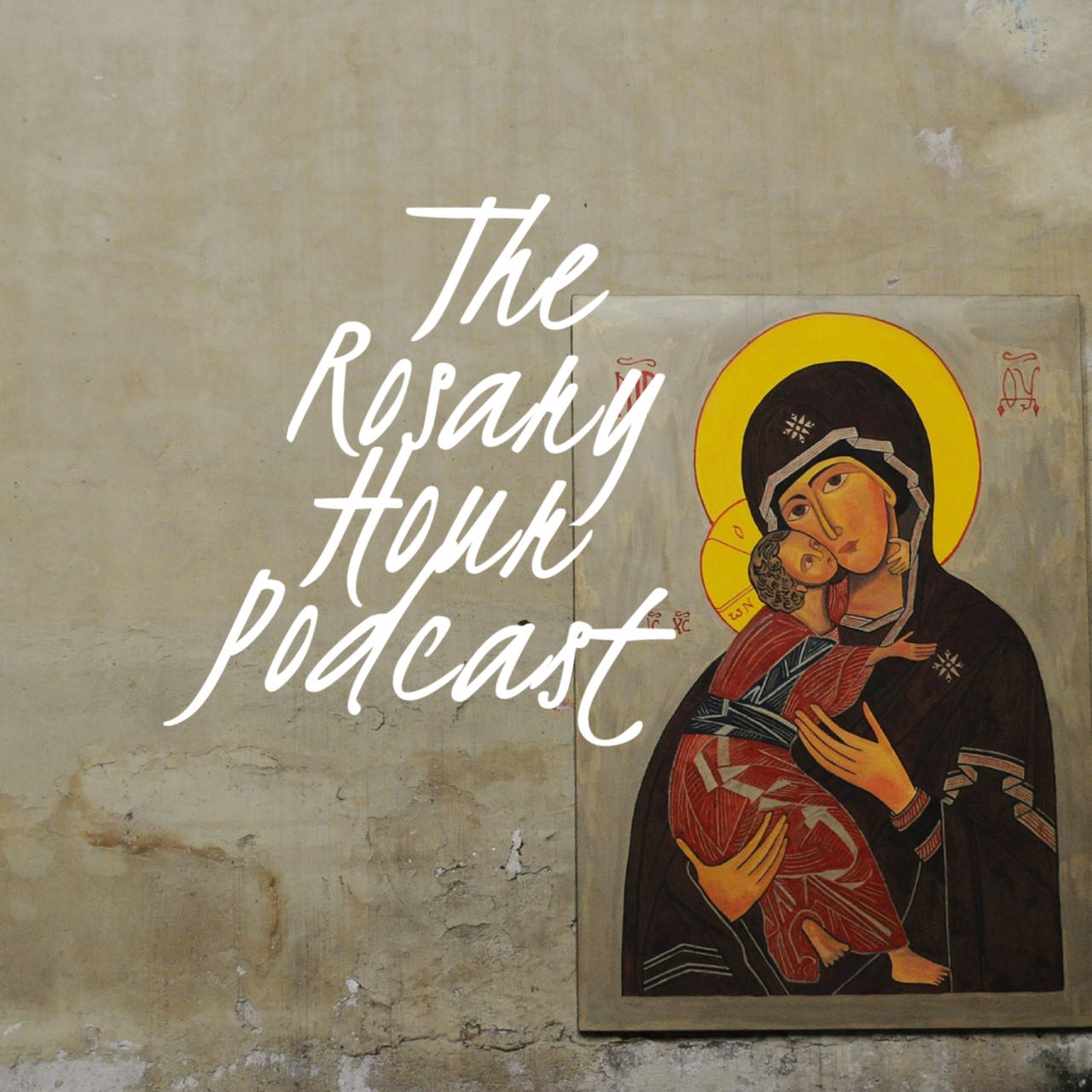ETERNAL WISDOM

Sunday 18 May 2025 | Pope Leo XIV began his homily citing St. Augustine
“Lord, You have made us for yourself, O Lord, and our heart is restless until it rests in you.” (St. Augustine)
THE ROSARY HOUR PODCAST NEWSLETTER | MAY 18, DOUBLE POST
On the parvis of Saint Peter’s Basilica, the Holy Father, Leo XIV presides over the Eucharistic Celebration for the Beginning of the Petrine Ministry of the Bishop of Rome.
He delivered the entire Holy Sacrifice of the Mass in the universal language of the Church — Latin, and then he had the Gospel sung in both Latin and sung (τραγούδι) in Greek, reminding us of the unifying force of the Cosmic Liturgy and the beauty of song articulated in the various melodies written for the Church Liturgy.
DOWNLOAD THE HOMILY OF HIS HOLINESS, POPE LEO XIV here: CLICK.
Here are some quick highlights:
“It is always a question of loving as Jesus did”…
“All of us are living stones”…
Pope calls for “A United Church… for a reconciled world” to be “A small leaven of unity” and say to the world, “Look to Christ, come closer to Him… listen to his offer of Love”…
He asks us to “build a new world where peace reigns”.
He reminds, “This is the missionary spirit that must animate us.”
He urges: “We are called to offer God’s love to everyone”.
“This is the hour for love.”
“Let us build a missionary Church that opens its arms to the world” …
“Let us walk towards God and love one another”
https://www.vatican.va/content/leo-xiv/en.html
The Pope’s words at the Regina Caeli prayer, 18.05.2025
At the end of the Eucharistic Celebration for the beginning of his Petrine Ministry, the Holy Father Leo XIV, before reciting the Regina Caeli prayer, said the following words:
Before the Chanting of the Regina Caeli
His Holiness stated:
“As we conclude this celebration, I greet and thank all of you, the people of Rome and the faithful from many parts of the world, who wished to participate.
…
In the joy of faith and communion, we cannot forget our brothers and sisters who are suffering because of war. In Gaza, the surviving children, families and elderly are reduced to starvation. In Myanmar, new hostilities have cut short innocent young lives. Finally, war-torn Ukraine awaits negotiations for a just and lasting peace.
Therefore, as we entrust to Mary the service of the Bishop of Rome, Pastor of the universal Church, let us, from the “Barque of Peter,” look to her, Star of the Sea, Our Lady of Good Counsel, as a sign of hope. We implore her intercession for the gift of peace, for support and comfort for those who suffer, and for the grace for all of us to be witnesses to the Risen Lord.
SOUVENIR OF THE INAUGURATION | PDF DOWNLOAD
The Holy Father (via the Holy See Bulletin) has provided to the world the following “Libretto” - a PDF document that allows anyone to participate with translations in English, Latin, Greek and Italian with the replay:
In the book “Joseph Ratzinger Collected Works” in Volume XI: II entitled “Theology of the Liturgy” (Ignatius Press, San Francisco 2014), from pages 421-442 one can read an excellent argument for the “Theological Basis of Church Music” which provides an argument for the link between music and “the highest degree” and “inner exodus which liturgy always seeks to be and to become” (Ratzinger 455). In other words, this idea of “unity of all reality” which is manifested by the incarnation, provides one of the anthropological goals of Liturgical Music of the Church which “must be subject to that integration of the human state which appears before in the incarnational faith” and that the Liturgical Music must “in its inner character meet the requirements of the great liturgical texts — the Kyrie, Gloria, Credo, Sanctus, Agnus Dei” (Ratzinger 458).
He goes on to write another chapter that focuses on the concept of “Earthly and Heavenly Liturgy” and notes that the “fundamental principles of liturgical music are given” in these sentences which note that our “singing and music-making point to heaven, or rather that these come from heaven or are learned from heaven” and moves on to talk about the concept of “Liturgical togetherness” which reminds us that “the choir is not standing before a community that is listening like an audience that lets itself be sung to, but it is itself part of a community and sings for it in the sense of legitimately representing it or standing in for it” (citing Harnoncourt).
He also reminds in this question, “are we really allowed to sing in Latin if the people do not understand it” … and he summarizes that despite the call for the vernacular after Vatican II, in this way: “let us first disregard the fact that a text is not yet understandable to everyone just because it has been translated into each person’s mother tongue” and he goes on to cite Harnoncourt again pointing at the concept of “unity” in partaking in the “cosmic liturgy.”
For this reason, summarized in both chapters, we might have reason and opportunity today to review some key moments in the Holy Sacrifice of the Mass that begins now — sung in Latin and Greek and which can be reviewed in the replay. See this link:
LITANY TO THE SAINTS: THE HOLY MASS BEGINS WITH INVOKING THE INTERCESSION OF THE SAINTS IN HEAVEN

SANCTUS, SANCTUS, SANCTUS | SEE PAGE 71 of LIBRETTO PDF
Pope Benedict XVI noted that the “choral Sanctus has its justification even after the Second Vatican Council” (476). Pope Leo XIV’s scholar will sing with the assembly the following version (De Angelis). Use the PIANO SCORE ABOVE to play … and see the Plain Song below:
One can also study by ROTE the melody of this version (albeit in PORTUGUESE) with this video from Missa VIII:
PATER NOSTER:
The following prayers, "Per omnia saecula saeculorum," "Oremus," "Amen" in this recording from FISHEATERS taken from a Latin Mass comes before the Our Father which starts at 0:28
Pater noster, qui es in caelis,
sanctificetur Nomen tuum.
Adveniat regnum tuum.
Fiat voluntas tua, sicut in caelo et in terra.
Panem nostrum quotidianum da nobis hodie,
et dimitte nobis debita nostra
sicut et nos dimittimus debitoribus nostris.
Et ne nos inducas in tentationem, sed libera nos a malo.
See the Plain song in the Papal Libretto PDF on pages 85 and 86 of the PDF
LEARN THE “AGNUS DEI” from the MASS VIII, GREGORIAN CHANT LESSON w/ SCORE
Again, go to the piano to learn the music for today’s Holy Mass with the score below:
FINALLY — LEARN THE “AVE, VERUM CORPUS” (pg. 95/96 from today’s PDF)
Latin lyrics to ‘Ave Verum Corpus’?
Ave verum Corpus, natum de Maria Virgine:
vere passum, immolatum in cruce pro homine.
Cuius latus perforatum fluxit aqua et sanguine;
esto nobis praegustatum mortis examine.
O Iesu dulcis! O Iesu pie! O Iesu, fili Mariae!1
THE MASS ENDS with the REGINA CAELI, once again in LATIN
Learn with this little girl and her father from Chant School:
Thank you for reading the Rosary Hour Podcast Newsletter. Please share with others this post to invite them to be part of today’s special set of broadcasts as we begin our novena for Pope Leo XIV and for the Church with this Holy Mass which continues this minute as Pope Leo XIV has just entered the Procession after the Litany to the Saints.
If possible, please pray the Rosary for the Pope and for the Church for Day 1 of our 40 day novena after this Holy Mass | The Glorious Mysteries. Link to the Scriptural readings here:
https://www.vatican.va/special/rosary/documents/misteri_gloriosi_en.html
FYI:
WITNESS OF MARIAN DEVOTION: POPE LEO XIV & OUR LADY IN 2019
FOOTNOTES
Mozart’s Ave Verum Corpus:

























Share this post